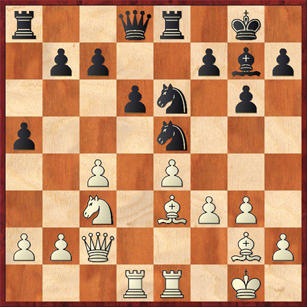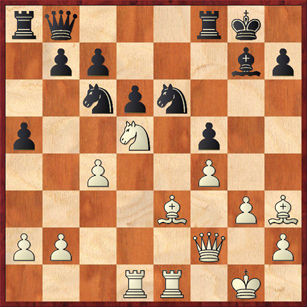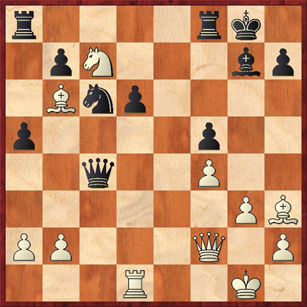One of the nice things about tournament chess, as compared with (say) poker or basketball or most other sports, is the almost complete lack of chatter or “trash talking.” In kids’ tournaments it’s not too unusual to see players talking to each other, but in adult tournaments it virtually never happens. The Code of Silence is observed almost religiously by most players: no talking with your opponent, except to resign, offer a draw, or occasionally to adjust a piece. It’s considered gauche even to announce a check.
But I can remember one exception to the Code of Silence, and it came in one of the most important games of my chess career! It came in the fifth round of the 1987 North Carolina championship. I was paired against Rich Jackson, a national master whom I had played a few times before. (I was at the time still an expert.) We got to the following position, where he has just played 15. … Nd7-e5:
Black’s move was probably a mistake, because it allows White to play 16. c5, piling up pressure on the pinned d-pawn. However, after long consideration I decided not to play this move, and I played 16. Nd5 instead. Rich looked at me, grinned, and said, “Chicken!”
After twenty years, I can say that Rich was at least partially right. I did chicken out, at least a little bit. I was pretty sure that he had something planned against 16. c5, but I also didn’t really see what his answer was going to be. During the game, I thought he was going to respond with 16. … Nc4?, but White can parry this move effortlessly with 17. Bf2, and now Black has two problems instead of one — a loose knight on c4 and the pinned pawn on d6. I suspect that Rich’s idea was actually to play 16. … Qc8, setting the trap 17. cd cd 18. Rxd6? Nc4!, when Black is fine. But White doesn’t have to fall into this. Instead of 18. Rxd6? I can just play 18. Rc1 with a great position — Black has so many weaknesses (b5, d5, and the dark squares on the queenside) that it is hard to count them all.
By the way, this shows the importance of considering quiet moves (like 17. Bf2 and 18. Rc1) even in what appears to be a tactical position. This relates to Aziridine’s comment on my recent post, “From the Mailbag” — the fact that a capture is possible does not mean it is obligatory. Even good players fall into this mental trap.
But even acknowledging that I got bluffed here, was 16. Nd5 such a bad move? In fact, it’s a very good move, centralizing the knight, taking it off the vulnerable square c3, and controlling squares deep in Black’s camp! According to Fritz, White’s advantage after 16. c5 is 0.9 pawns, while after 16. Nd5 his advantage is 0.6 pawns. This isn’t a big enough difference, in my opinion, to qualify 16. Nd5 as a mistake. It’s simply the second-best move. When you have a Plan B that’s as good as 16. Nd5, perhaps there is nothing wrong with giving up on Plan A.
This reminds me of a well-known anecdote. In the game Winter–Lasker, Nottingham 1936, Winter thought for about half an hour and then played a piece sacrifice. Lasker declined the sacrifice almost immediately. When asked why after the game, the former world champion said, “If a strong master thinks for half an hour and leaves a piece en prise, I think I had better not take it.” So there you have it: Even a world champion says it’s okay to chicken out now and then! Two important considerations here were the facts that declining the sac gained Lasker half an hour on the clock, and that Lasker had a strong Plan B, as I did in the above position.
And indeed, I think that Rich’s “Chicken!” comment may have boomeranged against him, because it’s possible that he relaxed a bit after I played 16. Nd5. In short order he found himself in a lot of trouble again:
16. Nd5 Nc6 17. Qf2 Qb8 (I’m not sure what the point of this move is, but it’s also hard to find constructive alternatives.) 18. f4! (Threatening f5 and f6.) 18. … f5 19. ef gf 20. Bh3 Rf8.
White to play and strike a blow for chickens everywhere!
Here I wanted to open up the e-file to attack his loose knight on e6, but at the same time I have to keep the d4 square adequately defended. Can you figure out what my solution was?
The answer is 21. Bb6! Black can’t defend the knight with 21. … Ncd8 because of 22. Bxf5!, and the trade 21. … cb 22. Rxe6 is too horrible to even look at, leaving Black with multiple weaknesses and no counterplay. So 21. … Qc8 was forced, and I followed up with the obvious sham sacrifice, 22. Rxe6! Qxe6 23. Nxc7 Qxc4.
Now, alas, I spoiled all my good work. Once again I forgot that just because a capture is threatened, it doesn’t have to be played! White should first play a simple prophylactic move, 24. b3!, and then after (say) 24. … Qf7 25. Nxa8 Rxa8 26. Rxd6 with an overwhelming advantage. Looking at the game now, I can’t believe I didn’t play this obvious zwischenzug.
Instead I got too caught up in the he-takes-I-take mentality, and continued 24. Nxa8? Rxa8 25. Bxf5 Qxa2 26. Rxd6 Qxb2 27. Qxb2? Bxb2 28. Rd7 a4! Oops! Suddenly I realized that I had no way of blockading the a-pawn (if I move my bishop to a2 it will be driven away by Black’s knight). So the only thing for White to do is take all of Black’s pawns and sac a bishop for the a-pawn — which leads to an endgame that should be drawn, with three pawns versus a piece.
But that’s not how the game ended! There were some amazing twists and turns and changes of fortune still to come — and a highly instructive rook-and-pawn endgame. Stay tuned for Part 2!






{ 2 trackbacks }